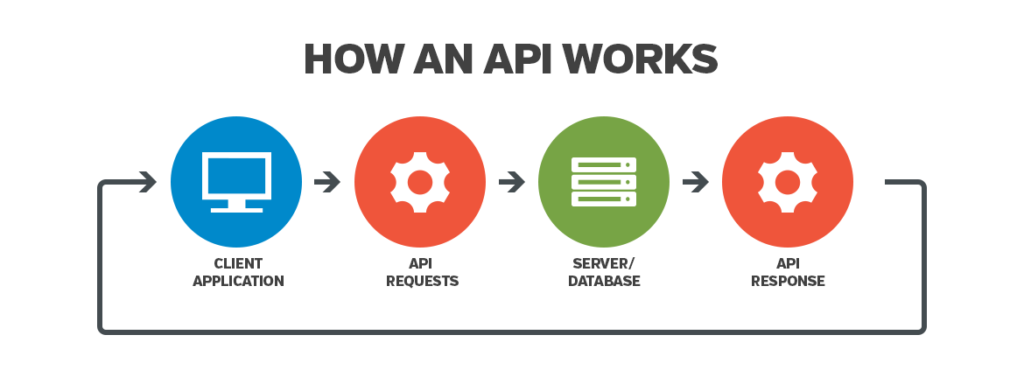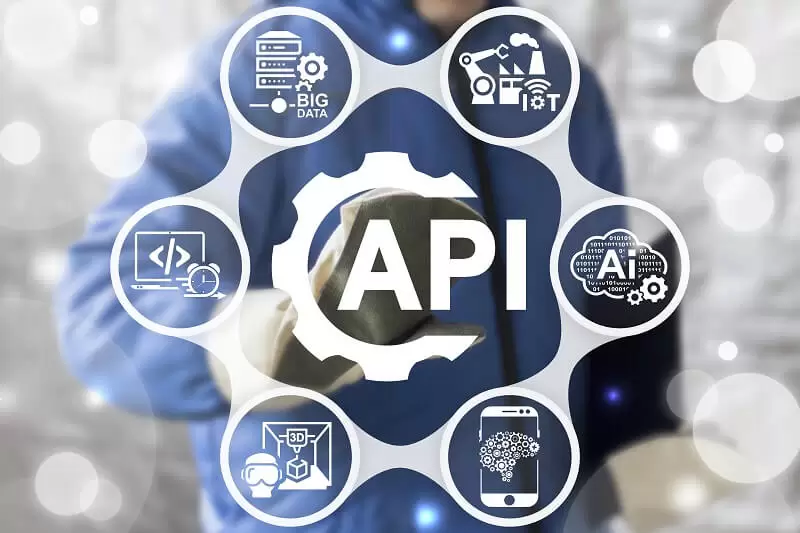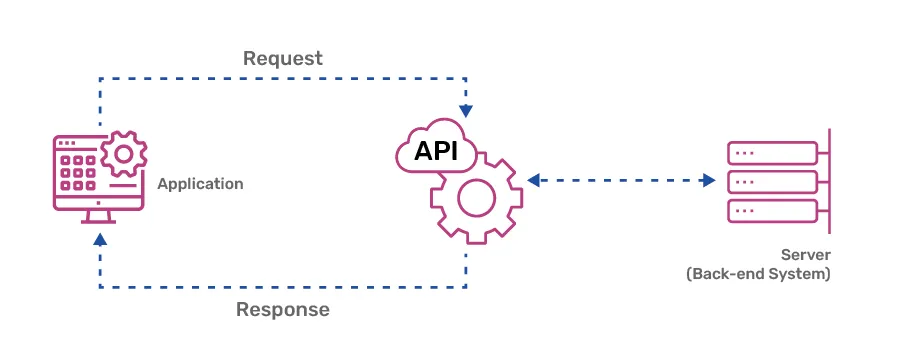Ever wonder how your favorite apps seamlessly communicate with each other? How does your weather app know the forecast, or how a travel booking site accesses flight information from various airlines? The secret lies in APIs (Application Programming Interfaces).
These behind-the-scenes messengers serve as the powerhouses driving many digital interactions we often take for granted.
In today’s digital era, where interconnectedness and seamless integration are paramount, APIs have emerged as the backbone of modern mobile app development.
Think of APIs as messengers. They act like delivery persons, conveying your request to the provider and returning the response. Facilitating data exchange and functionalities between different applications and systems, APIs drive innovation and efficiency across industries.

Here, we’ll explore the fundamental concepts of APIs, demystify their workings, and delve into real-world applications. We’ll discuss their benefits, use cases, and various types to help you kickstart your project.
By comprehending APIs, you develop a richer understanding of the intricate network of connections that drive the digital tools we rely on daily.
An API, or Application Programming Interface, serves as an intermediary between diverse software applications. It enables them to interact and share data in a structured manner.
An API is a set of protocols, tools, and definitions that allows different software applications to communicate and interact with each other and ensure smooth data exchange between different programs.
It defines how software components should interact, making it easier for developers to integrate and use functionalities from other applications or services without understanding their underlying codebase.

APIs serve as bridges facilitating seamless communication and data exchange among diverse systems. They drive interoperability and enable the creation of robust software solutions.
Case Study: Airbnb Enhances User Experience with Google Maps API
To grasp APIs better, dive into this case study illustrating how Airbnb harnesses key elements of mobile app development and API functionalities to elevate user experience and drive app success.
Airbnb, a global online marketplace, connects travelers with hosts offering unique accommodations worldwide.
API technology has played a pivotal role in Airbnb’s ascent as a premier online travel marketplace. A standout feature is its interactive map functionality, empowering users to search for listings based on location.
Let’s explore how Airbnb leverages the Google Maps API for value-added services:
Integration of Google Maps API:
Displays map markers for listings and showcases nearby amenities, allowing users to visualize the neighborhood before booking.Enhanced Search and Filtering:
Utilizes geocoding and geolocation capabilities of the Google Maps API, enabling users to search for listings based on specific criteria like proximity to landmarks or points of interest.Interactive Map Features:
Incorporates Google Maps API to offer interactive features such as zooming, panning, and street view.Real-Time Availability and Pricing:
Integrates real-time data from its platform with the Google Maps API, showcasing availability and pricing information directly on the map.By seamlessly integrating the Google Maps API, Airbnb has elevated user experience, enhanced search capabilities, provided valuable location-based services, and facilitated smooth navigation for hosts and guests.
API architecture isn’t daunting once you grasp the fundamentals. Positioned as the intermediary between client and server, the API facilitates communication: the client sends requests, and the server responds accordingly.
In essence, APIs establish protocols and tools, dictating the rules that enable disparate software applications to seamlessly communicate and interact.

Initiating Request:
The process begins with an application, often a client like a web browser or mobile app, initiating a request to access a service or resource provided by another application or system. This request usually contains specific instructions or data the client seeks to retrieve, modify, or interact with.Authentication:
Before proceeding with the request, the API may require authentication to verify the identity and permissions of the client. This step ensures that only authorized users or applications can access the requested resources. Authentication mechanisms commonly include API keys, OAuth tokens, or other secure authentication methods.Processing the Request:
Once authenticated, the API processes the client’s request according to predefined rules and protocols. This may involve tasks such as querying databases, executing business logic, accessing external services, or retrieving data from other systems.Data Exchange:
The API facilitates structured data exchange between the client and server. Commonly used data formats include JSON (JavaScript Object Notation), XML (eXtensible Markup Language), or binary formats. The exchanged data includes request parameters, response payloads, error messages, and metadata.Generating Response:
After processing the request, the API generates a response containing the requested information or an acknowledgment of the action taken. This response is then sent back to the client application, typically accompanied by an appropriate HTTP status code indicating the outcome of the request (e.g., 200 for success, 404 for not found, etc.)APIs can be classified into different types depending on their functionality, design, or use cases. Here are the primary categories of APIs based on their access level, architecture, or protocol:

Types of APIs by Access Level:
Public APIs (Open APIs):
These are freely available for anyone to use. While registration and obtaining an API key for security purposes may be required, the core functionality is accessible to all developers. Examples include weather APIs, social media platform APIs, and map services APIs.
Partner APIs:
Access to these APIs is granted exclusively to specific authorized developers or companies. Partners typically undergo an application process and may be required to pay a fee to use the API. Examples include APIs provided by financial institutions and data aggregators, which share information with approved businesses.
Internal APIs:
These APIs are intended for internal use within a single organization. They enable different teams within a company to share data and functionality among their private applications. Internal APIs play a crucial role in streamlining communication and development processes within large organizations.
This is the most common type of API architecture, following a set of design principles that prioritize lightweight, stateless communication. REST APIs utilize HTTP verbs (GET, POST, PUT, DELETE) to interact with data and are generally easy to integrate with various applications.
SOAP APIs serve as a heavier alternative to REST. They rely on XML for data exchange and adhere to a stricter communication protocol. While less prevalent than REST nowadays, SOAP APIs are still utilized in some enterprise applications that prioritize high security and reliability.
These APIs enable applications to execute procedures on a remote server. They can be implemented using different protocols, such as XML-RPC or JSON-RPC.
Exploring Specific API Protocols
A newer technology gaining popularity, GraphQL is a query language for APIs, enabling clients to request specific data from the server. It offers flexibility in defining response structures, reducing data over-fetching and under-fetching.
WebSocket APIs facilitate real-time, bidirectional communication between clients (e.g., web browsers or mobile apps) and servers. Unlike traditional HTTP-based APIs, WebSocket APIs allow for persistent connections, ideal for low-latency applications like chat apps and real-time dashboards.
JSON-RPC (JSON Remote Procedure Call) and XML-RPC (XML Remote Procedure Call) are protocols enabling remote procedure calls (RPCs) between distributed systems. They use JSON or XML as the data format, facilitating remote method invocation and data exchange across platforms and programming languages.
APIs are the silent engines driving many aspects of our digital lives, seamlessly integrating functionalities and enriching user experiences. Here are a few examples illustrating the pervasive role of APIs in everyday applications:
Social Media Integration APIs:
Facebook Graph API: Enables developers to access and interact with Facebook’s social graph data, facilitating features like social login, posting to timelines, and social interaction analysis.
Payment Gateway APIs:
Stripe API: Empowers businesses to securely accept online payments, manage subscriptions, and handle refunds, supporting various payment methods and checkout experiences.
Weather Data APIs:
OpenWeatherMap API: Provides real-time and forecast weather information globally, facilitating weather-related functionalities in applications and smart devices.
E-commerce APIs:
Amazon MWS (Marketplace Web Service) API: Allows sellers to automate inventory management, order processing, and shipping tasks on Amazon’s marketplace.
Social Media Analytics APIs:
Twitter API: Offers access to Twitter’s social media data for analysis, sentiment monitoring, hashtag tracking, and custom dashboard creation.
These examples underscore the indispensable role of APIs in modern application development. From data retrieval to seamless functionality, APIs serve as the invisible backbone of our digital experiences.
As a business owner seeking to develop an innovative and user-friendly app, partnering with a professional mobile development company is paramount. With their expertise, you can leverage the full potential of APIs to enhance your business mobile application development.
Embrace a world of possibilities by integrating APIs such as social media integrations, payment gateways, maps and geolocation services, and communication tools into your company’s mobile app. This enables you to deliver robust solutions that cater to the evolving needs of users.
